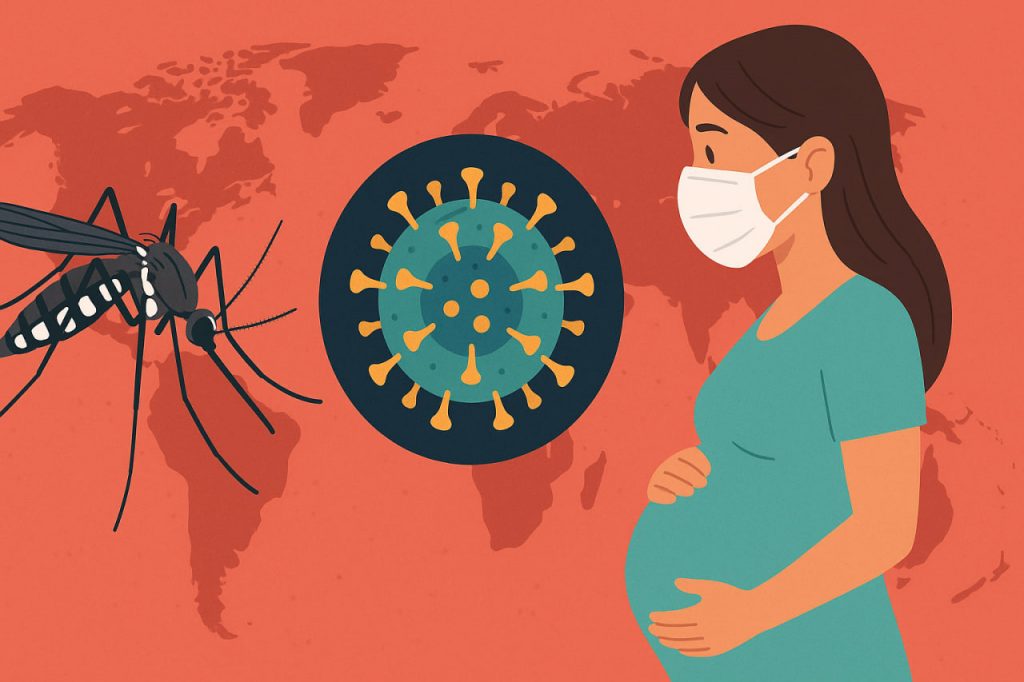The Zika virus is a mosquito-borne pathogen that became a global public health concern in the mid-2010s due to its link to severe birth defects. First discovered in 1947 in Uganda’s Zika Forest, the virus remained relatively obscure for decades until major outbreaks occurred in the Pacific and the Americas. The virus is primarily transmitted by Aedes mosquitoes, which also carry dengue and chikungunya. Zika infections are usually mild in adults, but its ability to cross the placental barrier and affect fetal development makes it a serious concern for pregnant women.
Transmission and Geographic Spread
Zika virus is mainly spread through the bite of infected Aedes aegypti mosquitoes. These mosquitoes are active during daylight hours and thrive in tropical and subtropical regions. Apart from mosquito bites, Zika can also be transmitted through sexual contact, blood transfusions, and from mother to fetus during pregnancy.
Major outbreaks occurred between 2013 and 2016 in countries such as Brazil, Colombia, and various Pacific islands. The rapid geographic spread and neurological complications associated with the virus led the World Health Organization (WHO) to declare a Public Health Emergency of International Concern (PHEIC) in 2016. Since then, global case numbers have declined, but sporadic outbreaks still occur.
Symptoms and Clinical Presentation
In most people, Zika virus infection is either asymptomatic or causes only mild flu-like symptoms. When present, symptoms include fever, rash, joint pain, headache, and conjunctivitis (red eyes). These usually appear within 3 to 14 days after exposure and last less than a week.
However, the virus has been linked to more severe outcomes. In adults, rare cases of Guillain-Barré syndrome, a neurological disorder causing muscle weakness and paralysis, have been reported. The most concerning complication is microcephaly, a birth defect where babies are born with abnormally small heads and underdeveloped brains.
Diagnosis and Testing
Diagnosing Zika infection is challenging due to the overlap of symptoms with other viruses like dengue and chikungunya. Laboratory tests are needed to confirm infection, including RT-PCR (reverse transcriptase-polymerase chain reaction) to detect viral RNA and serologic tests for antibodies.
However, cross-reactivity with other flaviviruses complicates antibody testing. Because of this, PCR testing is most reliable within the first week of symptom onset. Testing is especially recommended for pregnant women who may have been exposed in affected areas.
Prevention and Control Strategies
There is no specific antiviral treatment or approved vaccine for Zika virus as of now. Prevention focuses on mosquito control and personal protection. Measures include eliminating standing water where mosquitoes breed, using insect repellents, wearing long sleeves and pants, and installing window screens.
For travelers to Zika-affected areas, precautions are advised, especially for women who are pregnant or planning to become pregnant. Public health campaigns have also emphasized safe sex practices, since the virus can be sexually transmitted for weeks after infection.
Research and Vaccine Development
Researchers around the world are actively working on Zika vaccines, using technologies such as inactivated viruses, DNA-based platforms, and mRNA approaches. Several vaccine candidates have reached clinical trial stages, but none have yet received global regulatory approval.
In addition to vaccine development, scientists are exploring genetically modified mosquitoes and Wolbachia bacteria to reduce mosquito populations and transmission. These biological control methods may offer sustainable long-term solutions to prevent Zika and similar mosquito-borne diseases.
Conclusion
The Zika virus is a reminder of how emerging infections can rapidly evolve into international health threats. While most infections are mild, the virus’s impact on fetal development and its broad transmission pathways demand ongoing surveillance, prevention, and research. Understanding Zika’s biology and behavior is essential not only for controlling future outbreaks, but also for preparing for similar global health challenges.
Glossary
- Zika virus — a mosquito-borne virus associated with birth defects and neurological complications
- Aedes aegypti — a mosquito species responsible for transmitting Zika, dengue, and chikungunya
- Microcephaly — a congenital condition where a baby is born with an abnormally small head and brain
- Guillain-Barré syndrome — a rare neurological condition linked to viral infections
- RT-PCR — a molecular diagnostic test used to detect viral genetic material
- Wolbachia — bacteria used to infect mosquitoes to reduce virus transmission
- Flavivirus — a group of viruses that includes Zika, dengue, yellow fever, and West Nile virus


